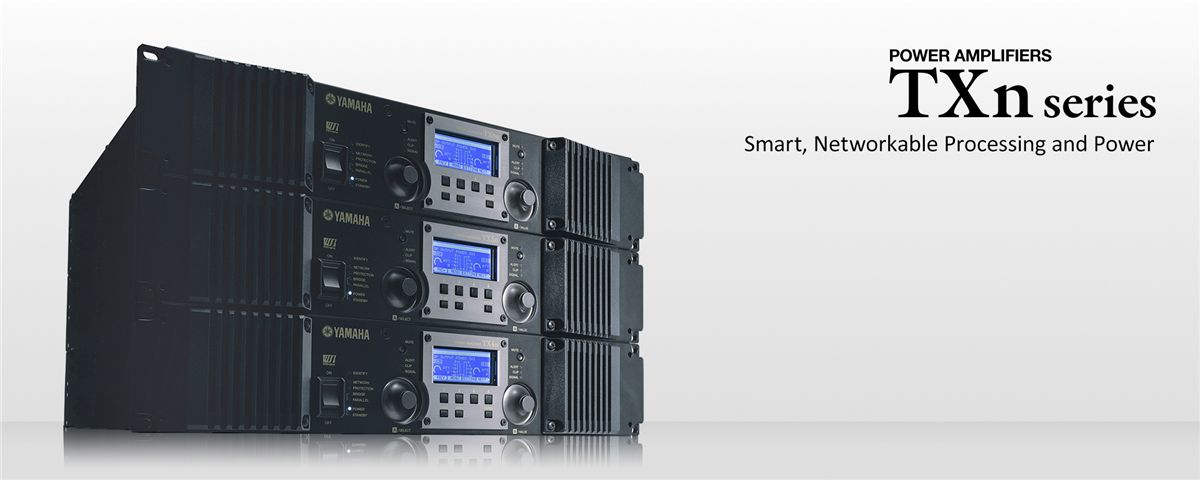TXn Series Power Amplifiers
General questions for power amplifiers
How much power output of a power amplifier is necessary for the power rating of a speaker to be used?
Generally speaking, to obtain the maximum output of a speaker to be used without clipping the amp, you can choose an amplifier that can deliver the same power as the PGM power rating of the speaker. If the PGM power rating is not described, the reference value is half the MAX/peak power rating (or twice as much as the NOISE/continuous power rating). For example, when driving 2 units of S115V speaker (PGM 500W @ 8 ohms) with the P-S series amp, P5000S (525W x 2 @ 8 ohms) is suitable to obtain the maximum output of the speaker. However, your required output power differs depending on the type of source signals and required sound pressure level in addition to the speakers to be used. For example, while a momentary clipping that can hardly be felt does not generally matter, in demanding applications such as studio monitoring system, where even a brief moment of clipping is not allowed, you may be required to choose an amp with higher output power. Also, if your application is background music in an installed sound system where the required sound pressure level is low, you may choose an amp with lower output power. However, if using a lower-power amp, please be careful not to drive the amp into clipping. Even if the output power of your amp is lower than the power rating of a speaker, clipping the amp can damage the speaker driver easily.
Is there a power amplifier that can be used for a high-impedance connection (constant voltage distribution)?
As of April 2011, power amplifiers supporting a high-impedance connection are as follows.
What is the difference between a high-impedance connection and standard low-impedance connection?
A high-impedance speaker connection, which is used for the distributed speaker system in many installations, allows numerous speakers to be connected to a single power amp, and to perform long-distance transmission. A speaker transformer that raises the impedance to several hundred or thousand ohms is added to the speaker. This allows the speaker to be effectively driven with much lower current than is required for a low-impedance system. That, in turn, makes it possible to connect a larger number of speakers in parallel to each power amp output. High-impedance speaker connections work at a specific maximum voltage - usually 70 or 100 volts - and are therefore also referred to as "constant voltage" speaker systems (the label "constant voltage" is somewhat misleading: the actual output voltage fluctuates according to the input signal).
Can each power amp handle a 2-ohm load such as connecting two speakers of 4 ohms in parallel?
As of April 2011, the following six models support 2-ohm drive: TX6n, TX5n, TX4n, T5n, T4n, and T3n The specifications of the PC-1N and XP series show the dynamic power output at 2-ohm load (20ms). However, this does not guarantee the continuous use under a 2-ohm load. Depending on the source signal type, the amps may be able to be used at 2-ohm load if the signal level is within the level where audio clipping only rarely occurs. However, there may be the case where the amps are continuously driven only by fewer than half the output power at 4-ohm load.
How much is the power consumption of each amplifier? How much power supply capacity is necessary?
Power consumption measured at 1/8 output is described in the Specifications page (Products>Power Amps>(Each amp page)>Specifications). 1/8 output (9dB lower than the maximum) is an assumed condition where an ordinary music signal clips occasionally. This value can be used as a reference to estimate the required power supply capacity. However, if the amp is driven into clipping continuously or the source music signal is extremely compressed (narrow dynamic range) and level-maximized, it may require approximately twice the value.
What is EEEngine?
EEEngine is a Yamaha's proprietary amplifier driving technology that delivers Class AB sonic performance with highly efficient power consumption.
What is a 5-way binding post? If my amp has both 5-way binding post and speakON connectors for the speaker outputs, can I use both connectors at the same time?
The 5-way binding post is a terminal that allows the connection of several different types of connectors such as bare wire, Y-plug, and banana plug. The 5-way binding post and speakON connectors are internally connected in parallel and can be used at the same time. When you connect speakers to the amp using both connectors, be careful of the speaker load. (When connecting two speakers of 4 ohms in parallel, the speaker load becomes 2 ohms.)
If my amp has both an XLR connector and a phone connector for the input, can I send a signal input from the XLR connector through the phone connector to the next amp?
Yes. Audio signal can be sent through either connector because the XLR connector and phone connector are internally connected in parallel. However, audio signals cannot be mixed by inputting the signals from both connectors. If your amp has an XLR connector and Euroblock connector for the input, audio signal can be sent through either connector as well.
What is inrush current?
Inrush current refers to the instantaneous electric current drawn to a device when switched on.
Power amp with linear power supply using transformer has comparatively higher value, but not proportionally high to the power consumption. For example, the power consumption of P3500S (390W@8Ω×2) is 350W and the inrush current is 142A. For the system using multiple power amps especially with transformer power supply, it should be considered not to start up multiple power amps at the same time in the system.
The existing power amp models with transformers are P3500S, P2500S, P1000S, XP3500, XP2500, and XP1000 (Total 6 models). Among the above models, XP3500, XP2500, and XP1000 are equipped with inrush current suppression circuit, and suitable for use with a lot of power amps such as installation applications.
What is voltage gain?
Voltage gain refers to the ratio of the output voltage to its input voltage when the attenuator of the power amp is set to its maximum (generally 0 dB).
As long as power amps have the same value, even if they have different rated output power, the same input level will generate the same output level until each power amp reaches the rated output. In this case, the different rated output causes the difference in input sensitivity.
When driving speakers in multi-amp mode with speaker processors, if the voltage gains for the power amps are different, the speaker preset recommended by the manufacturer will not function properly.
For the professional power amps from Yamaha except the XM and XH series, all amps in the same series keep the consistent voltage gain. Therefore, as long as using the power amps in the same series, it allows you to combine the different models with the most suitable output, e.g. large output models for low frequency drive, small output models for high frequency drive, and build an efficient system. (Incidentally, the voltage gains are variable in the TXn series, switchable between 26 dB or 32 dB in the Tn and XP series, fixed 32 dB in the PC-1N series, and fixed 32.1 dB in the P-S series)
On the other hand, the XM and XH series has a constant input sensitivity. The XP series can also be set to a constant input sensitivity, and each rated output can be obtained for +4 dB input, which means the output level varies depending on the model even for the same input level.
What is rated output power?
Rated output power is the RMS (root mean square) or effective value of electric power that can be delivered continuously for several ten seconds to few minutes. The unit is W (Watt).
It is not a value that can be output continuously for a long period, but it would not matter in a practical operation because music signal and voice speech signal are generally not constant in level. When a signal like continuous sine wave is continuously driven at the rated output, the thermal protection circuit will be activated, which will reduce the output power to around 1/8 (-9dB).
What is input sensitivity?
t is the required input signal level to obtain the rated output when attenuator is in its maximum (generally 0dB). It also means the output signal will be clipped if a signal larger than the input sensitivity is being input with the attenuator at maximum. When the voltage gains are the same, the larger output model is, the larger its input sensitivity is, too.
If the load impedance is halved, the output power will be almost doubled since the voltage gain is constant. In this case, however, the input sensitivity will be a little smaller because the actual rated output will not be doubled.
What is the maximum input level?
The maximum input voltage that can be applied to the device without any clipping. The unit is mostly dBu.
If the input signal exceeds the value, it will be clipped even when the attenuator is turned down.
What is S/N ratio?
The difference between maximum output level and the background noise level without input signal in the unit of dB. The larger the value, less affected by noise, ie. better performance.
Generally, there is not much difference between the noise levels in the same series of power amps, so the model with larger output has better S/N ratio.
When rack mounting multiple power amps, is it necessary to leave space between each amp for heat dissipation?
Current models for all Yamaha power amps have cooling fan installed. Therefore, as long as the front and back of the rack are open, it is not necessary to leave any space between each amp when mounting.
To connect multiple speakers, which of parallel or serial connection is recommended?
When connecting multiple speakers with a single power amp, either of parallel or serial connection can be used.
Generally parallel connections are more common, but the combined impedance of the speakers will become half for two speakers, and 1/4 for four speakers. Therefore, it is necessary to be sure that the impedance would not be lower than the load impedance supported by the power amp.
In serial connection, the combined impedance will be simply calculated by adding all the speaker impedances. In order to drive many speakers, it is recommended to combine serial and parallel connections.
What is damping factor?
It is a specification of power amps and calculated by the following formula: speaker load impedance / power amp output impedance.
Larger value is better. It is also said how efficiently the electric current flows into the speaker unit.
The damping factor in actual use can be calculated as follows: speaker load impedance / (power amp output impedance + (round trip) resistance of speaker cables)
This implies the cross-sectional area and length of the speaker cables significantly affect the factor.
Speakers produce sound by vibrating the diaphragm with the electric power from power amp. However, because of the vibrating part weight and the damper elasticity, it is like hanging a weight on a spring. Even if the audio signal is stopped, the vibration will not be able to stop so quickly. It is more obvious on the woofer with heavy weight. The vibration will produce electromagnetic induction and result in electric power, but the electric current caused by the induction will be counter force to the vibration. If the induced current is shorted with low resistance as much as possible to maximize the power to suppress the vibration and strengthen the power of spring, the unwanted vibration will be converged quickly which will produce a sharp sound.
How do STEREO, PARALLEL, and BRIDGE modes operate?
STEREO: Each channel operates independently. Input signal and attenuator are also separated between each channel.
PARALLEL: Input signal is connected to only a single channel, and the same output signals are obtained from two adjacent channels. Attenuator operates independently.
BRIDGE: Two channels of power amp output work as a single channel with doubled output. Only a single attenuator operates. The voltage gain will be increased by 6dB, and the minimum load impedance will be doubled. For details on connecting the speaker output, please refer to the manual that came with each power amp.







